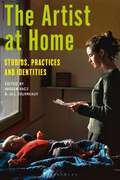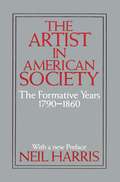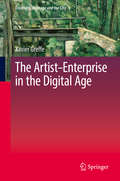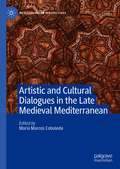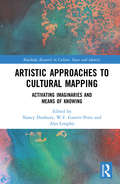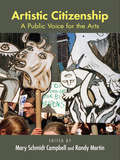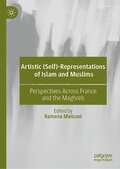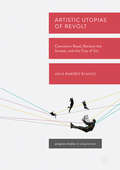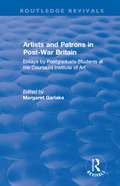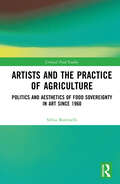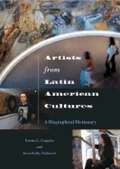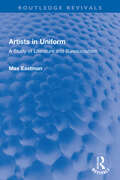- Table View
- List View
The Artist at Home: Studios, Practices and Identities
by Imogen Racz and Jill JourneauxArtists have worked from home for many reasons, including care duties, financial or political constraints, or availability and proximity to others.From the 'home studios' of Charles and Ray Eames, to the different photographic representations of Robert Rauschenberg's studio, this book explores the home as a distinct site of artistic practice, and the traditions and developments of the home studio as concept and space throughout the 20th and into the 21st century.Using examples from across Europe and the Anglophone world between the mid-20th century and the present, each chapter considers the different circumstances for working at home, the impact on the creative lives of the artists, their identities as artists and on the work itself, and how, sometimes, these were projected and promoted through photographs and the media. Key themes include the gendered and performative aspects of women practising 'at home', collaborative studio communities of the 1970s – 90s including the appropriation of abandoned spaces in East London, and the effects of Covid on artistic practices and family life within the spaces of 'home'. The book comprises full-length chapters by artists, architects, art and design historians, each of whom bring different perspectives to the issues, interwoven with short interviews with artists to enrich and broaden the debates. At a time when individual relationships to home environments have been radically altered, The Artist at Home considers why some artists in previous decades either needed to or chose to work from home, producing work of vitality and integrity. Tracing this long tradition into the present, the book will provide a deeper understanding of how the home studio has affected the practices and identity of artists working in different countries, and in different circumstances, from the mid-20th century to the present.
The Artist at Home: Studios, Practices and Identities
Artists have worked from home for many reasons, including care duties, financial or political constraints, or availability and proximity to others.From the 'home studios' of Charles and Ray Eames, to the different photographic representations of Robert Rauschenberg's studio, this book explores the home as a distinct site of artistic practice, and the traditions and developments of the home studio as concept and space throughout the 20th and into the 21st century.Using examples from across Europe and the Anglophone world between the mid-20th century and the present, each chapter considers the different circumstances for working at home, the impact on the creative lives of the artists, their identities as artists and on the work itself, and how, sometimes, these were projected and promoted through photographs and the media. Key themes include the gendered and performative aspects of women practising 'at home', collaborative studio communities of the 1970s – 90s including the appropriation of abandoned spaces in East London, and the effects of Covid on artistic practices and family life within the spaces of 'home'. The book comprises full-length chapters by artists, architects, art and design historians, each of whom bring different perspectives to the issues, interwoven with short interviews with artists to enrich and broaden the debates. At a time when individual relationships to home environments have been radically altered, The Artist at Home considers why some artists in previous decades either needed to or chose to work from home, producing work of vitality and integrity. Tracing this long tradition into the present, the book will provide a deeper understanding of how the home studio has affected the practices and identity of artists working in different countries, and in different circumstances, from the mid-20th century to the present.
The Artist in American Society: The Formative Years
by Neil HarrisWhat was the place of the artist in a new society? How would he thrive where monarchy, aristocracy, and an established church—those traditional patrons of painting, sculpture, and architecture—were repudiated so vigorously? Neil Harris examines the relationships between American cultural values and American society during the formative years of American art and explores how conceptions of the artist's social role changed during those years.
The Artist–Enterprise in the Digital Age (Creativity, Heritage and the City #1)
by Xavier GreffeThis book is a monograph of cultural economics of a new concept, artist–enterprises. It explores various dimensions that artists embody, i.e., aesthetic, critical, messianic, and economic ones, and screens the multiple challenges faced by the artist–enterprises in terms of pricing, funding, and networking in the Digital Age. It shows how these artist–enterprises are at the core of the contemporary creative industries.Even when they are on their own, artists have to demonstrate or manage a variety of skills, sign contracts both in the early and later stages of their activities, and also maintain relationships and networks that enable them to attain their artistic and economic goals. They are no longer simply entrepreneurs managing their own skills but are the enterprises themselves. The artist–enterprises thus find themselves at the confluence of two dynamics of production—artistic and economic: artistic because they invent new expressions and meanings; and economic because these expressions must be supported by monetary values on the market. The artistic dynamic is part of a long process of artistic enhancement and only an artist can say whether it has reached the point of presentation or equilibrium. The economic dynamic is dependent on the constant endorsement of artists' works by the market to ensure their survival as artist–enterprises. The tension created by this disparity is further aggravated by another tension: the need to overcome a number of risks so that artist–enterprises can progress.This book will be of special interest to artists, managers, students, professionals, and researchers in the fields of the arts, creativity, economics, and development.The author is Emeritus Professor at the University Paris I Panthéon-Sorbonne.
Artistic and Cultural Dialogues in the Late Medieval Mediterranean (Mediterranean Perspectives)
by María Marcos CobaledaThis book analyses the artistic and cultural legacy of Western Islamic societies and their interactions with Islamic, Christian and Jewish societies in the framework of the late medieval Mediterranean, from a range of multi-disciplinary perspectives. The book, organised in four parts, addresses the Andalusi legacy from its presence in the East and the West; analyses the relations and transfers between Al-Andalus and the artistic productions of the Christian kingdoms of the Iberian Peninsula; explores other manifestations of the Andalusi legacy in the fields of knowledge, construction, identity and religious studies; and reconsiders ornamental transfers and exchanges in artistic manifestations between East and West across the Mediterranean basin.Chapter 2 is open access under a CC BY 4.0 license.
Artistic Approaches to Cultural Mapping: Activating Imaginaries and Means of Knowing (Routledge Research in Culture, Space and Identity)
by Nancy Duxbury W. F. Garrett-Petts Alys LongleyMaking space for imagination can shift research and community planning from a reflective stance to a "future forming" orientation and practice. Cultural mapping is an emerging discourse of collaborative, community-based inquiry and advocacy. This book looks at artistic approaches to cultural mapping, focusing on imaginative cartography. It emphasizes the importance of creative process that engages with the "felt sense" of community experiences, an element often missing from conventional mapping practices. International artistic contributions in this book reveal the creative research practices and languages of artists, a prerequisite to understanding the multi-modal interface of cultural mapping. The book examines how contemporary artistic approaches can challenge conventional asset mapping by animating and honouring the local, giving voice and definition to the vernacular, or recognizing the notion of place as inhabited by story and history. It explores the processes of seeing and listening and the importance of the aesthetic as a key component of community self-expression and self-representation. Innovative contributions in this book champion inclusion and experimentation, expose unacknowledged power relations, and catalyze identity formation, through multiple modes of artistic representation and performance. It will be a valuable resource for individuals involved with creative research methods, performance, and cultural mapping as well as social and urban planning.
Artistic Approaches to Cultural Mapping: Activating Imaginaries and Means of Knowing (Routledge Research in Culture, Space and Identity)
by Nancy Duxbury W. F. Garrett-Petts Alys LongleyMaking space for imagination can shift research and community planning from a reflective stance to a "future forming" orientation and practice. Cultural mapping is an emerging discourse of collaborative, community-based inquiry and advocacy. This book looks at artistic approaches to cultural mapping, focusing on imaginative cartography. It emphasizes the importance of creative process that engages with the "felt sense" of community experiences, an element often missing from conventional mapping practices. International artistic contributions in this book reveal the creative research practices and languages of artists, a prerequisite to understanding the multi-modal interface of cultural mapping. The book examines how contemporary artistic approaches can challenge conventional asset mapping by animating and honouring the local, giving voice and definition to the vernacular, or recognizing the notion of place as inhabited by story and history. It explores the processes of seeing and listening and the importance of the aesthetic as a key component of community self-expression and self-representation. Innovative contributions in this book champion inclusion and experimentation, expose unacknowledged power relations, and catalyze identity formation, through multiple modes of artistic representation and performance. It will be a valuable resource for individuals involved with creative research methods, performance, and cultural mapping as well as social and urban planning.
Artistic Citizenship: A Public Voice for the Arts
by Mary Schmidt CampbellArtistic Citizenship asks the question: how do people in the creative arts prepare for, and participate in, civic life? This volume, developed at NYU’s Tisch School, identifies the question of artistic citizenship to explore civic identity – the role of the artist in social and cultural terms. With contributions from many connected to the Tisch School including: novelist E.L. Doctorow, performance artist Karen Finley, theatre guru Richard Schechner, and cultural theorist Ella Shohat, this book is indispensable to anyone involved in arts education or the creation of public policy for the arts.
Artistic Citizenship: A Public Voice for the Arts
by Mary Schmidt Campbell Randy MartinArtistic Citizenship asks the question: how do people in the creative arts prepare for, and participate in, civic life? This volume, developed at NYU’s Tisch School, identifies the question of artistic citizenship to explore civic identity – the role of the artist in social and cultural terms. With contributions from many connected to the Tisch School including: novelist E.L. Doctorow, performance artist Karen Finley, theatre guru Richard Schechner, and cultural theorist Ella Shohat, this book is indispensable to anyone involved in arts education or the creation of public policy for the arts.
Artistic Creation and Ethical Criticism (Thinking Art)
by Ted NannicelliArtistic Creation and Ethical Criticism, a study in philosophical aesthetics, investigates an idea that underpins the ethical criticism of art but that is rarely acknowledged and poorly understood - namely, that the ethical criticism of art involves judgments not only of the attitudes a work endorses or solicits, but of what artists do to create the work. The book pioneers an innovative production-oriented approach to the study of the ethical criticism of art - one that will provide a detailed philosophical account of the intersection of ethics and artistic creation as well as conceptual tools that can guide future philosophizing and criticism. Ted Nannicelli offers three arguments concerning the ethical criticism of art. First, he argues that judgments of an artwork's ethical value are already often made in terms of how it was created, and examines why some art forms more readily lend themselves to this form of ethical appraisal than others. He then asserts that production-oriented evaluations of artworks are less contested than other sorts of ethical criticism and so lead to certain practical consequences-from censure, dismissal, and prosecution to shifts in policy and even legislation. Finally, Nannicelli defends the production-oriented approach, arguing that it is not only tacit in many of our art appreciative practices, but is in fact rationally warranted. There are many cases in which we should ethically critique artworks in terms of how they are created because this approach handles cases that other approaches cannot and results in plausible judgments about the works' relative ethical and artistic value. The concise, powerful arguments presented here will appeal to moral philosophers, philosophers of art and aesthetics, and critics interested in the intersection of artistic production and criticism and ethics.
Artistic Creation and Ethical Criticism (Thinking Art)
by Ted NannicelliArtistic Creation and Ethical Criticism, a study in philosophical aesthetics, investigates an idea that underpins the ethical criticism of art but that is rarely acknowledged and poorly understood - namely, that the ethical criticism of art involves judgments not only of the attitudes a work endorses or solicits, but of what artists do to create the work. The book pioneers an innovative production-oriented approach to the study of the ethical criticism of art - one that will provide a detailed philosophical account of the intersection of ethics and artistic creation as well as conceptual tools that can guide future philosophizing and criticism. Ted Nannicelli offers three arguments concerning the ethical criticism of art. First, he argues that judgments of an artwork's ethical value are already often made in terms of how it was created, and examines why some art forms more readily lend themselves to this form of ethical appraisal than others. He then asserts that production-oriented evaluations of artworks are less contested than other sorts of ethical criticism and so lead to certain practical consequences-from censure, dismissal, and prosecution to shifts in policy and even legislation. Finally, Nannicelli defends the production-oriented approach, arguing that it is not only tacit in many of our art appreciative practices, but is in fact rationally warranted. There are many cases in which we should ethically critique artworks in terms of how they are created because this approach handles cases that other approaches cannot and results in plausible judgments about the works' relative ethical and artistic value. The concise, powerful arguments presented here will appeal to moral philosophers, philosophers of art and aesthetics, and critics interested in the intersection of artistic production and criticism and ethics.
Artistic Enclaves in the Post-Industrial City: A Case Study of Lawrenceville Pittsburgh (SpringerBriefs in Sociology)
by Geoffrey MossThis SpringerBriefs presents a case study and theoretical analysis of an artistic enclave that emerged within Lawrenceville Pittsburgh. It briefly describes the history of greater Pittsburgh, and Lawrenceville’s transition from thriving blue-collar community to depopulated low-income neighborhood to gentrifying site of artistic and creative culture. It draws on multiple methods (e.g., interviews, observations, and survey data) to discuss the advantages and disadvantages associated with being a Pittsburgh artist, and offer a detailed description of the origins and ongoing development of Lawrenceville’s artistic enclave. It discusses this enclave in the context of sociological, historical, and interdisciplinary work on urban artistic communities (i.e., bohemian and quasi-bohemian communities), and situates it within the larger urban artistic tradition, and within its contemporary urban context. It maintains that this enclave constitutes a successful (i.e., sustainable) example of an artistic creative class enclave, a heuristic concept that clarifies and amends Richard Florida’s brief commentary on contemporary urban artistic life. It concludes by offering policy suggestions for those who wish to promote such enclaves, and a preliminary critical appraisal of their potential impact on society.
Artistic Practices: Social Interactions and Cultural Dynamics (Studies in European Sociology)
by Tasos ZembylasArt matters. It affects us in our daily lives and is full of meanings that are valuable to all of us. As a catalyst for social interactions, art may either cause public conflict and create dissensions or facilitate mutual understanding and strengthen collective bonds. All of this is grounded in practices that develop and change along social interaction, cultural dynamics, as well as technological and economic lines. So how is art formed and produced? What are the relevant constraints and challenges that artists experience in the creative process? And what constitutes artistic agency? This collection of contributions from international, interdisciplinary experts explores particular case studies to deeply analyse artistic practices. Comprising eleven chapters relating to different art forms, each chapter offers an original perspective conveying a comprehensive understanding of artistic practices as arrays of specific activities in contemporary art worlds. This book will be important for both researchers and practitioners in the field. It will help artists to deepen their analytical abilities, enabling them to further their own creative practice. It will allow students and researchers to gain insights into processes of artistic creation and thus into the reproduction of art, as well as innovation in the arts.
Artistic Practices: Social Interactions and Cultural Dynamics (Studies in European Sociology)
by Tasos ZembylasArt matters. It affects us in our daily lives and is full of meanings that are valuable to all of us. As a catalyst for social interactions, art may either cause public conflict and create dissensions or facilitate mutual understanding and strengthen collective bonds. All of this is grounded in practices that develop and change along social interaction, cultural dynamics, as well as technological and economic lines. So how is art formed and produced? What are the relevant constraints and challenges that artists experience in the creative process? And what constitutes artistic agency? This collection of contributions from international, interdisciplinary experts explores particular case studies to deeply analyse artistic practices. Comprising eleven chapters relating to different art forms, each chapter offers an original perspective conveying a comprehensive understanding of artistic practices as arrays of specific activities in contemporary art worlds. This book will be important for both researchers and practitioners in the field. It will help artists to deepen their analytical abilities, enabling them to further their own creative practice. It will allow students and researchers to gain insights into processes of artistic creation and thus into the reproduction of art, as well as innovation in the arts.
Artistic (Self)-Representations of Islam and Muslims: Perspectives Across France and the Maghreb
by Ramona MieluselArtistic (Self)-Representations of Islam and Muslims: Perspectives Across France and the Maghreb is a collection of essays that explores the question of artistic representation(s)/self-representation(s) of Muslim religious and cultural identity in France, the Maghreb and in/between since the 2000s. The volume offers a plurality of feminine and masculine voices and points of view on cultural Islam (Franco-French, Franco-Maghrebi, Maghrebi), all the while addressing the impact of events like 9/11, the tragic attacks in France in 2015-2016 (Charlie Hebdo, Stade de France, Bataclan, Nice), and the Arab Spring. Taken together, the volume features a transnational and transversal set of artistic voices that are not looking for consensus, but rather invoke dissensus (Rancière) and a full range of expression. A necessary part of that full range of expression is (self)-representations: Muslims representing themselves, though this is no facile (self)-representations, as artists continue to use the properties of the imagination and performance to complexify an easy reading, reductive meaning, or oversimplified interpretation. This interdisciplinary study contributes to the fields of French and Francophone Studies, Humanities and Global/Cultural Studies such as political studies, sociology, political philosophy, literature, cinema, visual arts and media studies with a focus on broadening views on the topic of Islam and Muslim (self)-representations across disciplines.
Artistic Utopias of Revolt: Claremont Road, Reclaim the Streets, and the City of Sol (Palgrave Studies in Utopianism)
by Julia Ramírez BlancoThis book analyses the aesthetic and utopian dimensions of various activist social movements in Western Europe since 1989. Through a series of case studies, it demonstrates how dreams of a better society have manifested themselves in contexts of political confrontation, and how artistic forms have provided a language to express the collective desire for social change.The study begins with the 1993 occupation of Claremont Road in east London, an attempt to prevent the demolition of homes to make room for a new motorway. In a squatted row of houses, all available space was transformed and filled with elements that were both aesthetic and defensive – so when the authorities arrived to evict the protestors, sculptures were turned into barricades. At the end of the decade, this kind of performative celebration merged with the practices of the antiglobalisation movement, where activists staged spectacular parallel events alongside the global elite’s international meetings. As this book shows, social movements try to erase the distance that separates reality and political desire, turning ordinary people into creators of utopias. Squatted houses, carnivalesque street parties, counter-summits, and camps in central squares, all create a physical place of these utopian visions
Artistic Utopias of Revolt: Claremont Road, Reclaim the Streets, and the City of Sol (Palgrave Studies in Utopianism)
by Julia Ramírez BlancoThis book analyses the aesthetic and utopian dimensions of various activist social movements in Western Europe since 1989. Through a series of case studies, it demonstrates how dreams of a better society have manifested themselves in contexts of political confrontation, and how artistic forms have provided a language to express the collective desire for social change.The study begins with the 1993 occupation of Claremont Road in east London, an attempt to prevent the demolition of homes to make room for a new motorway. In a squatted row of houses, all available space was transformed and filled with elements that were both aesthetic and defensive – so when the authorities arrived to evict the protestors, sculptures were turned into barricades. At the end of the decade, this kind of performative celebration merged with the practices of the antiglobalisation movement, where activists staged spectacular parallel events alongside the global elite’s international meetings. As this book shows, social movements try to erase the distance that separates reality and political desire, turning ordinary people into creators of utopias. Squatted houses, carnivalesque street parties, counter-summits, and camps in central squares, all create a physical place of these utopian visions
Artists and Patrons in Post-war Britain
by Courtauld Institute of ArtThis title was first published in 2001. An examination of art and patronage in Britain during the post-war years. It consists of five case studies, initially written as MA theses, that closely investigate aspects of the mechanisms of patronage outside the state institutions, while indicating structural links within it. The writers have sought to elucidate the relationship between patronage, the production of art and its dissemination. Without seeking to provide an inclusive account of patronage or art production in the early post-war years, their disparate and highly selective papers set up models for the structure of patronage under specific historical conditions. They assume an understanding that works of art are embedded in their social contexts, are products of the conditions under which they were produced, and that these contexts and conditions are complex, fluid and imbricated in one another.
Artists and Patrons in Post-war Britain
by Courtauld Institute of ArtThis title was first published in 2001. An examination of art and patronage in Britain during the post-war years. It consists of five case studies, initially written as MA theses, that closely investigate aspects of the mechanisms of patronage outside the state institutions, while indicating structural links within it. The writers have sought to elucidate the relationship between patronage, the production of art and its dissemination. Without seeking to provide an inclusive account of patronage or art production in the early post-war years, their disparate and highly selective papers set up models for the structure of patronage under specific historical conditions. They assume an understanding that works of art are embedded in their social contexts, are products of the conditions under which they were produced, and that these contexts and conditions are complex, fluid and imbricated in one another.
Artists and the Practice of Agriculture: Politics and Aesthetics of Food Sovereignty in Art since 1960 (Critical Food Studies)
by Silvia BottinelliArtists and the Practice of Agriculture maps out examples of artistic practices that engage with the aesthetics and politics of gathering food, growing edible and medicinal plants, and interacting with non-human collaborators. In the hands of contemporary artists, farming and foraging become forms of visual and material language that convey personal and political meanings. This book provides a critical analysis of artistic practices that model alternative food systems. It presents rich academic insights as well as 16 conversations with practicing artists. The volume addresses pressing issues, such as the interconnectedness of human and other-than-human beings, the weight of industrial agriculture, the legacy of colonialism, and the promise of place-based and embodied pedagogies. Through participatory projects, the artists discussed here reflect on the links between past histories, present challenges, and future solutions for the food sovereignty of local and networked communities. The book is an easy-to-navigate resource for readers interested in food studies, visual and material cultures, contemporary art, ecocriticism, and the environmental humanities.
Artists and the Practice of Agriculture: Politics and Aesthetics of Food Sovereignty in Art since 1960 (Critical Food Studies)
by Silvia BottinelliArtists and the Practice of Agriculture maps out examples of artistic practices that engage with the aesthetics and politics of gathering food, growing edible and medicinal plants, and interacting with non-human collaborators. In the hands of contemporary artists, farming and foraging become forms of visual and material language that convey personal and political meanings. This book provides a critical analysis of artistic practices that model alternative food systems. It presents rich academic insights as well as 16 conversations with practicing artists. The volume addresses pressing issues, such as the interconnectedness of human and other-than-human beings, the weight of industrial agriculture, the legacy of colonialism, and the promise of place-based and embodied pedagogies. Through participatory projects, the artists discussed here reflect on the links between past histories, present challenges, and future solutions for the food sovereignty of local and networked communities. The book is an easy-to-navigate resource for readers interested in food studies, visual and material cultures, contemporary art, ecocriticism, and the environmental humanities.
Artists Emerging: Sustaining Expression through Drawing (Routledge Revivals)
by Sheila Paine Tom PhillipsThis title was first published in 2000. Most children enjoy drawing and use it to express a wide range of experiences and emotions. Drawing can offer an avenue of expression where words fail. So why do many people stop drawing after the early school years? This is an examination of the early work of John Everett Millais, Henri de Toulouse-Lautrec, Pablo Picasso, Michael Rothenstein, Gerard Hoffnung, Sarah Raphael and David Downes to investigate the reasons why these artists were able to sustain and develop their drawing skill and expressive potential while others failed. The close study of these artists' early drawings reveals their sequences of progress and their eventual achievement. Sheila Paine, a former President of the National Society for Education in Art and Design, shares the experience of a lifetime's work in art education to explore the mysteries of drawing fluency, its often precocious beginnings, and the personal, social and cultural circumstances which help or hinder its development.
Artists Emerging: Sustaining Expression through Drawing (Routledge Revivals)
by Sheila Paine Tom PhillipsThis title was first published in 2000. Most children enjoy drawing and use it to express a wide range of experiences and emotions. Drawing can offer an avenue of expression where words fail. So why do many people stop drawing after the early school years? This is an examination of the early work of John Everett Millais, Henri de Toulouse-Lautrec, Pablo Picasso, Michael Rothenstein, Gerard Hoffnung, Sarah Raphael and David Downes to investigate the reasons why these artists were able to sustain and develop their drawing skill and expressive potential while others failed. The close study of these artists' early drawings reveals their sequences of progress and their eventual achievement. Sheila Paine, a former President of the National Society for Education in Art and Design, shares the experience of a lifetime's work in art education to explore the mysteries of drawing fluency, its often precocious beginnings, and the personal, social and cultural circumstances which help or hinder its development.
Artists from Latin American Cultures: A Biographical Dictionary (Non-ser.)
by Kristin G. Congdon Kara Kelley HallmarkLatin Americans have long been relegated to the cultural background, obscured by the dominant European culture. This biographical dictionary profiles 75 artists from the United States and 13 nations of Central and South America and the Caribbean, including painters, sculptors, photographers, muralists, printmakers, installation artists, and performance artists. Some of their works recall pre-Columbian times; others confront the cultural imperialism of the U.S. over Latin America; and many explore how the dominant elements of culture can affect identities of class, gender, and sexuality.Profiled artists range from the renowned to the little-known: Frida Kahlo; Tina Modotti; Diego Rivera; Myrna Baez; Raquel Forner; Patrocino Barela; and many more. Color photographs are provided for many of the works. Each entry includes information about the artist's childhood, schooling, creative growth, and artistic styles and themes. Exemplary artworks and influences are described, along with a look at popular and critical responses. Supplemental features include artist cross references, a glossary of essential terms from the art world, and a number of vivid photos portraying the artists in their creative environments.
Artists in Uniform: A Study of Literature and Bureaucratism (Routledge Revivals)
by Max EastmanFirst published in 1934, Artists in Uniform confronts what the author describes as ‘two of the worst features of the Soviet experiment’ following Lenin’s death – bigotry and bureaucratism – and shows how they have functioned in the sphere of arts and letters. It is divided into three parts: The Artist’s International; A Literary Inquisition; and Art and the Marxian Philosophy.
